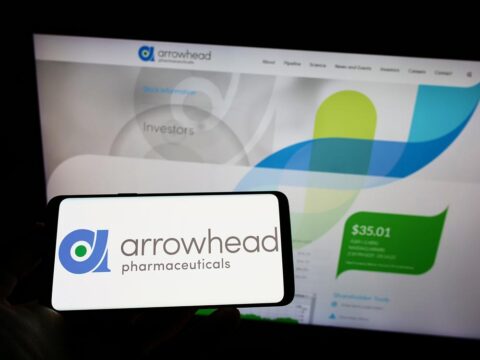Advertisment
Additional data from 4 year update of ongoing phase 1/II study of valoctocogene roxaparvovec gene therapy for severe hemophilia A presented at World Federation of Hemophilia virtual summit.- BioMarin
BioMarin Pharmaceutical Inc. announced additional data from its previously reported four-year update of an open-label Phase 1/II study of valoctocogene roxaparvovec , an investigational gene therapy treatment for severe hemophilia A. The results were presented during a late-breaking oral presentation at the World Federation of Hemophilia (WFH) Virtual Summit by Professor John Pasi, M.B., Ch.B., Ph.D., from Barts and the London School of Medicine and Dentistry and Chief Investigator for this Phase 1/II study.
The data presented at WFH is the most current data (April 8, 2020, cut off) and includes four years of data for the 6e13 vg/kg cohort and three years of data for the 4e13 vg/kg cohort.
Annualized Bleed Rate and Factor VIII Use in 6e13 vg/kg Cohort : In the six study participants who were previously on Factor VIII prophylaxis in the 6e13 vg/kg cohort, the data showed substantial and sustained reductions in bleeding that required Factor VIII infusions. In the year prior to treatment with valoctocogene roxaparvovec, the mean Annualized Bleed Rate (ABR) was 16.3 and the median was 16.5. During the four years following treatment with valoctocogene roxaparvovec, the cumulative mean ABR was 0.8, which represents a 95% reduction from baseline. In the fourth year, the mean ABR was 1.3 and the median was zero . There was a 96% reduction in mean Factor VIII usage to 5.4 infusions per year cumulatively over four years from the baseline of 135.6 infusions per year. Among all seven study participants in the 6e13 vg/kg cohort, 86% or six out of seven were bleed-free in the fourth year. All participants remain off Factor VIII prophylaxis therapy .
.
Annualized Bleed Rate and Factor VIII Use in 4e13 vg/kg Cohort: Similarly, in the six study participants in the 4e13 vg/kg cohort, the data showed substantial and sustained reductions in bleeding requiring Factor VIII infusions following treatment with valoctocogene roxaparvovec. All participants remain off Factor VIII prophylaxis therapy. In the year prior to treatment with valoctocogene roxaparvovec, the mean ABR was 12.2 and the median was 8.0. The cumulative mean ABR was reduced by 93% to 0.9 with continued absence of target joint bleeds in 5 of 6 subjects during the three years observed, which represents a 93% reduction from baseline. During the third year of follow-up, the mean ABR was 0.5 and the median was zero (0), and 67% or four out of six study participants were bleed-free. Five out of six participants had no spontaneous bleeds. There was a 96% reduction in mean Factor VIII usage to 5.7 infusions per year cumulatively over three years from the baseline of 142.8 infusions per year.
Factor VIII Activity Levels for 6e13 vg/kg and 4e13 vg/kg Cohorts : For the 6e13 vg/kg and 4e13 vg/kg cohorts, mean Factor VIII activity levels over four and three years, respectively, support the observed reductions in bleed rates and annualized Factor VIII usage. All study participants had severe hemophilia A at baseline, defined as less than or equal to 1 IU/dL of Factor VIII activity. At the end of the fourth-year post-infusion with valoctocogene roxaparvovec, all patients continue to produce their own endogenous factor with the mean Factor VIII activity level of the 6e13 vg/kg cohort at 24.2 IU/dL as measured by the chromogenic substrate (CS) assay and at 35.4 IU/dL as measured by the One-Stage (OS) assay. The median Factor VIII activity levels at the end of the fourth year was 16.4 IU/dL as measured by the CS assay and 23.4 IU/dL as measured by the OS assay. These measurements are based on six of the seven participants, as an evaluable sample for the seventh study participant was not available.
Mean Factor VIII activity levels over three years similarly support the observed reductions in bleed rates and annualized Factor VIII usage for the 4e13 vg/kg cohort. At the end of the third year post-infusion with valoctocogene roxaparvovec, mean Factor VIII activity level of the 4e13 vg/kg cohort was 9.9 IU/dL as measured by the CS assay and 14.9 IU/dL as measured by the OS assay. The median Factor VIII activity levels at the end of the third year was 7.9 IU/dL as measured by the CS assay and 12.3 IU/dL as measured by the OS assay .
Safety Summary : Overall, the safety profile of valoctocogene roxaparvovec remains consistent with previously reported data with no delayed-onset, treatment-related events. No participants developed inhibitors to Factor VIII, and no participants withdrew from the study. No participants have developed thrombotic events. The most common adverse events associated with valoctocogene roxaparvovec occurred early and included transient infusion-associated reactions and transient, asymptomatic, and mild to moderate rise in the levels of certain proteins and enzymes measured in liver function tests with no long-lasting clinical sequelae.





